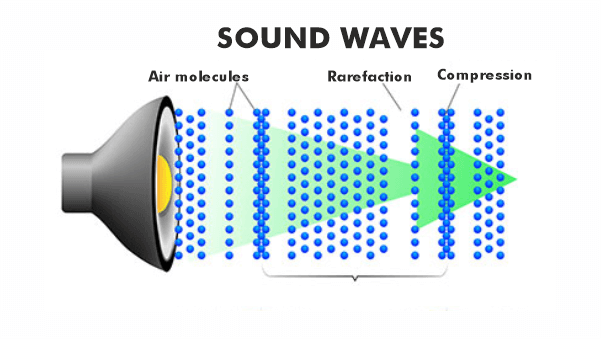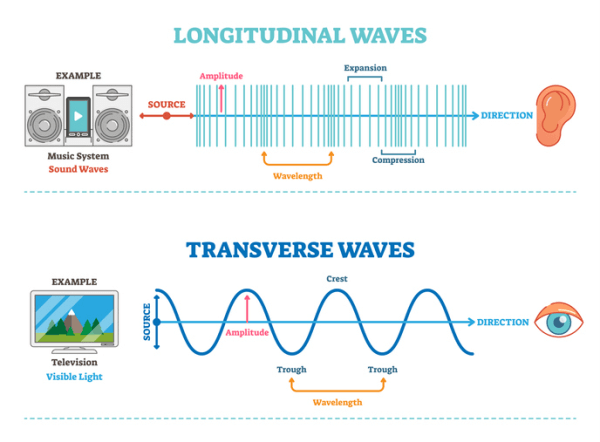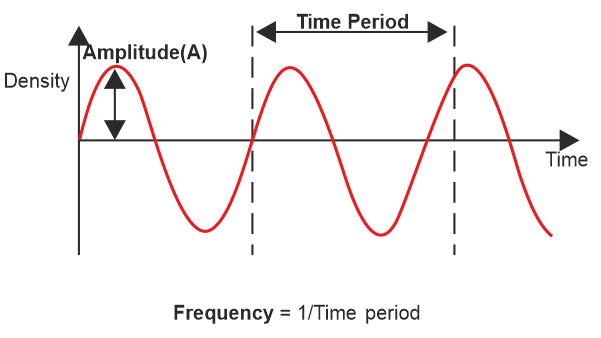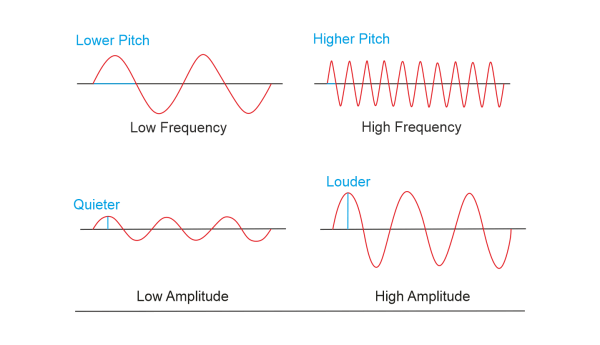Audible and Inaudible Sounds
The most crucial function that sound performs in our lives is that it facilitates communication. There are countless voices and sounds that we hear daily. Streams and rivers, ringing cellophane, a nail hit by a hammer, musical notes from an instrument, chirping of the birds, and human voices, all of these can be heard only because they make a sound.
What is sound?
We must first grasp what vibrations are to comprehend the theory of sound.
What is a vibration?
- It is an object's TO and FRO or back or forth.
- For instance, when a rubber band is expanded from one hand and pulled in the middle, it begins to swing back and forth. Or, put another way, it begins to vibrate.
- This vibration causes the sound to be made.
- Any vibrating object makes noise.
- Sound flows through some medium (like the three states of matter- solid, liquid, and gases) as a wave or vibration.
- Since no molecules can vibrate in a vacuum-like space, there won't be any sound. Sound is something that is audible.
- Let's use the straightforward scenario of bursting a balloon.
- When the balloon explodes, the high-pressure molecules surge to the surface and bombard or collide with the nearby air particles.
- These particles strike the subsequent set of neighbouring particles, and the cycle repeats.
- This causes a growing circle of air molecules to form, which simply collide.
- This is called a pressure wave or sound wave.
- As the wave propagates through space, the bouncing air molecules finally exert pressure on your eardrum, causing the internal ear's components to move.
- The motion in your internal ear is then analysed by your brain, which informs your cognition that the noise appears like a balloon bursting.
- Even though the sound of a balloon being punctured appears to be pretty simple, a cross-section zoomed in on the molecular level reveals a complicated pattern that shows how the air particles collide with one another.
- After the balloon is punctured, this pattern appears in a tenth of a second.
Where does this pattern come from?
- A high-pressure wave is created as the high-pressure molecules surge outward.
- But when they do, the core of the balloon is left with a low-pressure emptiness.
- The air molecules rush back in to fill this space, creating a low-pressure wave.
- A second high-pressure region is produced when the molecules hurry back in too quickly to fill the space.
- Every time this cycle repeats, high-pressure and low-pressure waves are produced.
- Compression occurs at high pressure when particles clump together, and when they scatter apart, rarefaction occurs at low pressure.
- Sound is created by combining these two processes.
- The sound wave is, therefore, a sequence of consecutive compressions plus rarefactions.

Medium of propagation of sound
Sound must travel through a medium in order to be heard. Solids, liquids, or gases can all serve as the medium for transmitting sound.
- We are aware that air is a combination of gases and that sound travels through it.
- An object's sound when it drops and breaks, the sound of a rocket, the siren that alerts you when an ambulance is approaching, and many other sounds use the air as their means of transmission.
- Let's look at the demonstration below to further understand how sound can propagate through liquids.
- Locate the bell inside the water-filled tub without letting it touch the bottom.
- Now shake the bell inside the water while keeping one of your ears adjacent to the tub. The sound is audible to us.
- Water (liquid) is used as the propagation medium here.

- Sound transmission via solid objects:
- Let's look at an example to further grasp this.
- Your heartbeat's frequency is measured by doctors using a stethoscope.
- Your chest is pressed against a diaphragm by medical professionals.
- Through the conduit, the heartbeat may be heard and picked up by the two earpieces.In this case, a solid (tube) is the propagation medium.
Can sound pass through any material at all?
- In a vacuum, sound cannot pass through.
- A vacuum is a region where the majority of the matter has been eliminated.
- For instance, the sound is not audible in space.
Let's discover more facts about sound waves
- In essence, sounds are vibrations.
- We may depict sound using unique designs that resemble a mountain and a valley.
- We refer to these graphics as waves because they resemble Miniature Mountains and valleys.
- Using the example, we can comprehend this. Think about how a speaker operates.
- For the speaker to produce sound, it needs to rise briefly before falling again (in other words, it has to move back and forth).
- It must complete its task quickly, in a little pulse.
- The air particles immediately in the vicinity of the loudspeaker will be pushed outward as a result of the speaker's back-and-forth movement.
- They will then collide with the next air particles neighbouring them.
- The process will then replicate as these molecules bombard the ones in front of them.
- The wave pulse from the speaker eventually gets transferred during this process.
- Unfortunately, this is not adequate to generate sound on its own.
- This pulse must occur regularly, or the procedure must be performed numerous times each second to produce sound.
- A sound wave can move at a speed of 340 m/s due to the vibration of air particles.
- However, when contrasted to water, which is denser and has molecules that are considerably closer, it can transport sound at a rate of roughly 1500 m/s.

Frequency
- Air particles that are vibrating as a result of the speaker's pulsing appear to be longitudinal waves.
- However, it is more practical to visualize sound waves as transverse waves.
- There are numerous waves in one second period in this diagram.
- For instance, we can state that the speaker vibrates at a pace of four pulses per second if four waves in the graph vibrate within one second.
- And this reveals information regarding frequency.
- The unit used to calculate frequency is the hertz. With this, we can infer that the speaker produces four hertz of sound.
- The range of 20 Hz to 20,00 Hz is the only spectrum the human ear can respond to.
- Any frequency beneath 20 hertz is referred to as subsonic. Human ears cannot detect a subsonic sound.
- Supersonic sound, which is defined as any noise with a frequency higher than 20,000 hertz, is undetectable by humans.
- We are raising the pitch as we raise the frequency.
Wavelength
- A transverse wave's width is measured in wavelengths.
- We get fewer pulses in a given time if our wavelength is longer. It denotes a low frequency and hence a lower pitch.
- A shorter wavelength, on the other hand, translates into more pulses delivered in a given amount of time. The pitch is high because the frequency is high.
Amplitude
The wave height will indicate the amplitude of a transverse wave. A shorter wave corresponds to a quieter sound in sound waves, and a longer wave corresponds to a bigger sound.

Characteristics of sound
Pitch
- This characteristic of a sound separates a grave sound from a shrill sound.
- Shrill sound, also known as narrow sound, is created when a sound's frequency is high. For instance, the sounds of cats and birds.
- Low-frequency sound produces a grave sound, which is a heavy sound. For instance, the sound of dogs and frogs.
- The frequency of a sound alters its pitch.
- A sound with a high frequency and a tiny wavelength is referred to be high-pitched. The sound of a guitar, for instance.
- Low-pitched note: The sound has a long wavelength and a low frequency. For instance, Dhol Sound.
Loudness
- Sound energy (or amplitude) affects how loud a sound is. The size of the sound increases with increasing sound energy and vice versa. It becomes a silent sound when the sound's amplitude is tiny.
- For instance, when you raise the speaker's level, the speaker amplifies the sound, which causes us to hear loud music.
Quality
- A characteristic of a sound allows two sounds of similar loudness and pitch to be recognized if various instruments produce them.
- Think about Sound 1 and Sound 2 as two examples.
- Sound 1 has a wavelength of 0.4 m, amplitude of 0.5, and a frequency of 20 hertz.
- 20 hertz is the frequency, 0.4 m is the wavelength, and 0.5 is the amplitude of sound number two.
- This indicates that both of these sounds' characteristics are similar.
- Even though two instruments have identical qualities, we can distinguish between their sounds if we play sound one on dhol and sound two on a piano.
- The sound's high quality makes this possible.

Classification of Sound
An object generates sound every time it vibrates. Variable frequency sounds are created when this happens. Therefore, these frequencies are crucial factors that inform us about the audibility of a sound at a given frequency.
Inaudible Sound
- Inaudible sounds are those with frequencies beneath 20 hertz or those which vibrate at a rate of fewer than 20 vibrations per second.
- The human ear is unable to perceive these sounds.
- They contain ultrasonic and infrasonic sounds, which we will investigate in the future section.
Audible Sound
- An audible sound is one that humans are capable of experiencing.
- The spectrum of audible frequencies for the human ear is around 20 hertz to 20,000 hertz.
- Accordingly, the bottom and top limits of the human hearing spectrum are 20 hertz and 20,000 hertz, or 20 kilohertz, respectively.
Conditions to produce audible sound
An object must vibrate at least 20 times in a second to make an audible sound. In other words, for an object to make an audible sound, its frequency must be at least 20 hertz.
Some animals can hear noises with a frequency of 20,000 hertz or higher. Dogs have this potential. Dogs can hear the high-frequency sirens used by the policemen, but people cannot.
Infrasonic Sound
- Infrasonic sounds have too low a frequency to be perceptible to people.
- Infrasonic sounds are those with frequencies of fewer than 20 hertz.
- Rhinoceros can make infrasonic sounds with frequencies under 20 hertz. They have infrasonic hearing too.
- For instance, a simple plumb bob oscillating creates sound.
- However, we cannot hear the simple plumb bob's sound as it resonates.
- This is so because a simple plumb bob has a very low frequency.
- As little as 2 to 3 hertz is produced as the frequency.
- Human ears are unable to pick up sounds at such low frequencies.
- It is an inaudible sound, which is a term for sounds that are not audible.
- We deduce from this example that not every vibrating thing emits audible sounds.
- We can also state that a plumb bob's sound in this experiment is infrasonic.
Ultrasonic Sound
- Ultrasonic sounds are those with frequencies that are too extreme for humans to hear.
- An ultrasonic sound is one that humans cannot hear, such as one with a frequency of 50,000 hertz.
- Both producing and hearing ultrasonic noises are not humanly possible. However, certain animals can both make and hear ultrasonic noises.
- Another example is the extremely high-pitched, well-beyond-our-hearing frequency of bat screams. They are in the ultrasonic range, so we cannot hear them.
- Dogs, monkeys, deer, and leopards are just a few of the creatures that can detect ultrasonic sounds. Some dog owners employ a unique high-frequency siren that only dogs can perceive because they can sense ultrasonic sounds.
- Additionally, to communicate with their dogs, the crime branch policemen utilize specialized high-frequency sirens that emit ultrasonic noises.
- Ultrasonic sound has a much stronger penetrating potential than regular sound because of its high frequency.
- Echoes are created when ultrasonic sound is reflected, like regular sound waves. But humans cannot hear the echoes that ultrasonic sounds produce. They can only be located using specialized tools.
- Ultrasonic sounds are used for a variety of things these days. Below are a few ultrasound applications:
- Medical technology uses ultrasonic sound as a diagnostic tool to examine the human body.
- The development of a foetus inside the mother's body is studied using ultrasonic sound.
- They are applied in the management of arthritis and muscle discomfort.
- It is employed to gauge the ocean's depth.
- It is also employed to find objects submerged in the water, including submarines, shipwrecks, and fish shoals.
- It should be remembered that infrasonic and ultrasonic sound waves travel at the same speed as audible sound waves.
Sample Questions
1. Give the differences between audible and inaudible sound.
| Audible Sound |
Inaudible Sound |
| Sounds that humans can perceive |
Sounds that humans cannot perceive |
| Frequency spectrum: 20 hertz to 20Khertz |
Frequencies: fewer than 20 hertz and above 20khertz |
2. Can sound propagate through a vacuum?
Sound cannot propagate through a vacuum. A place where the major part of the matter has been removed is called a vacuum. For instance, no sound can be detected in outer space.
3. What are inaudible and audible sounds?
Inaudible sounds are those with frequencies beneath 20 hertz or those which vibrate at a rate of fewer than 20 vibrations per second. The human ear is unable to perceive these sounds.
An audible sound is one that humans are capable of experiencing. The spectrum of audible frequencies is 20 hertz to 20,000 hertz.
4. What are the applications of ultrasonic sound?
Applications of ultrasonic sound include:
- It is employed to gauge the ocean's depth.
- They are applied in the management of arthritis and muscle discomfort.
- The development of a foetus inside the mother's womb is studied using ultrasonic sound.
- Medical technology uses ultrasonic sound as a diagnostic tool to examine the human body.
- It is also employed to find objects submerged in the water, including submarines, shipwrecks, and fish shoals.
|



 For Videos Join Our Youtube Channel: Join Now
For Videos Join Our Youtube Channel: Join Now











